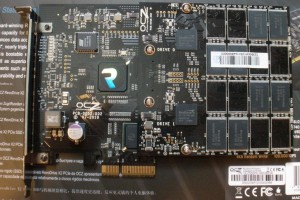‘My SSD Is Faster than Your HDD’ just doesn’t seem to fit the part when we are speaking of the OCZ RevoDrive x2 PCIe SSD. Anytime you consider a product that is controlled by four (4) SandForce SF-1200 series controllers, prepare to be amazed.
The RevoDrive x2 should knock your socks off with advertised specs of 740MB/s read and 690MB/s write and 4k random write of 100, 000 IOPS.
A few weeks back we had the opportunity to take the OCZ RevoDrive 120GB PCIe for a ride and were so impressed that we asked OCZ just how much better the RevoDrive x2 would be in PCMark Vantage testing. As the Vantage HDD Suite consists of 8 scenarios that simulate common user activities, our opinion is that this software is simply the best testing environment for any solid state drive. The Revo did so well, in fact, that it easily surpassed benchmarks that we had done with RAIDED SSDs just prior to that evaluation. Our curiosity was in the thought that, sooner or later, performance increase just had to reach a plateau….or so we thought.
INTRODUCTION
The RevoDrive x2 100GB PCIe SSD is constructed such that 4 x 25GB SSDs provide the speed in a RAID 0 configuration where all SSDs are controlled by the Silicon Image SiI3124 RAID 0 controller. Using 4 SSDs means that the ‘machine’ can take a job such as moving data and cut the single load into 4 smaller jobs of which all 4 are now completed simultaneously by each engine. The engines of this drive are the SandForce SF-1200 processors. The Revo x2 is available in capacities of 100GB, 160GB, 240GB, 360GB, 480GB and 960GB and performance for capacities 240GB and up increase to 740MB/s read and 720MB/s write with 120,000 IOPS at 4k random write access (aligned).
The Revo x2 is capable of these amazing speeds because it is installed by means of the PCIe x4 slot on desktop motherboards, thus eliminating bottlenecks of SATA II (3Gbps) and SATA III (6Gbps). The only concern that an enthusiast might have would be Revo x2 placement if available slots are already occupied by multiple Graphics cards. Other than that, its simply a click away from the fastest speed you will ever experience. There is also a quick driver download from OCZ if you want to make the card your boot drive and the package includes easily understood installation instructions.
Unlike the RevoDrive which consists of a single circuit board (PCB), the Rev x2 has two board that are considered to be a mother/daughter relationship. Each board has 2 x SandForce SF-1200 processors and each side of each board contains 8 x Intel multi-level cell 4GB 32nm NAND flash memory chips (29F32G08AAMDB) for a total of 128GB of storage. As SandForce processors rely on over provisioning for better performance and a longer lifespan of the drive, the total storage available to the user is reduced to the advertised 100GB.
TRIM, ITGC AND WEAR LEVELING ALGORYTHMS
Trim does not work in RAID because the software drivers have yet to be released that enable the passing of the TRIM command from software to hardware. To step back a bit, the process of deleting a file with SSDs is such that the index is simply removed which tricks the system into believing the space is available. This issue was recognized early on where extreme slowing was observed in SSDs that had reached the point where all their space had been written to because, then, writing a block of data meant reading the are to be written to, deleting old data and then writing new data.
 TRIM then came along where data blocks with deleted files were cleared automatically long before new data had to be written. This then ensured a faster SSD as the process of writing was simply reading the block to ensure it was clean and then writing the information.
TRIM then came along where data blocks with deleted files were cleared automatically long before new data had to be written. This then ensured a faster SSD as the process of writing was simply reading the block to ensure it was clean and then writing the information.
Wear Leveling algorithms are a process whereby the firmware can actually ensure that each block of NAND is used evenly. These work in tune with ITGC, or ‘Garbage Collection’ to ensure that every cell of the SSD is clear and ready for use.
Garbage collection and TRIM perform a similar function and SandForce processors are known to have an aggressive ITGC ability. It is the firmwares use of ITGC, wear leveling algorithms and DuraClass technology that ensures that the drive does not degrade in performance over time.
Both the Revo and Revo x2 have been available for some time and, quite frankly, there are few reviewers who haven’t tested to show performance degradation with the Revo SSD series. The result seems consistent in that there is none. We stated in the original review of the RevoDrive that the matching up of SandForce and OCZ in this venture was a mark of genius because the need for TRIM is simply no longer there.

PG 1 – Introduction
PG 2 – Test Protocol and Initial Testing
PG 3 – BenchMarks
PG 4 – PCMark Vantage Scoring & Conclusions
 The SSD Review The Worlds Dedicated SSD Education and Review Resource |
The SSD Review The Worlds Dedicated SSD Education and Review Resource | 

Great article! Thanks!